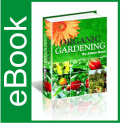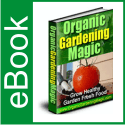Growing a Vegetable Garden
Growing a Vegetable Garden
Article by Ellen Bell
Growing a home vegetable garden has many benefits. For gardening enthusiasts, growing your own vegetables is a fun and rewarding hobby. For others, it’s a way to ensure you are eating safe produce because you know where it comes from. Controlling the application of chemical fertilizers, herbicides, and pesticides is easy; if you don’t want these things on the food you eat, then you can simply choose not to use them. For this reason, home vegetable gardening is the organic food lover’s dream.
But in addition to these benefits, did you also know that home vegetable gardening is a good way to save money? For as little as a investment at your local garden center, you can grow over 0 worth of fruits and vegetables in your own yard. During tough economic times, those numbers can really help out your pocketbook!
It is estimated that the number of U.S. families growing their own produce will increase by approximately 40% this summer. So what kinds of fruits and vegetables are these families growing? What are the best plants to put in your vegetable garden? We’ll evaluate some of the more commonly home grown produce items and review the basics of how to get started growing them yourself.
Tomatoes:Tomatoes are by far the most popular home grown produce item. They are extremely versatile and easy to grow. They don’t require a lot of care, and will produce well, even under less than desirable conditions. Tomatoes can be grown in almost any soil type, as long as they receive 4-5 hours of sunlight per day. Regular watering is preferable, though they will produce fruit even in dry conditions. Tomatoes can be purchased as small plants from your local garden center, but they are also quite simple to grow from seed. If growing from seed, you should start your plants indoors about 8 weeks before the last frost in your area.
Squash:Squash is another popular choice for home vegetable gardeners because of its heavy yields. One squash will easily feed a family of 3-4 people, or if you want to do some canning, 3 or 4 plants will be sufficient. There are many varieties of squash to choose from. Summer squash such as zucchini is a popular choice. Winter squashes such as acorn or butternut squash are harvested later in the fall and have a long shelf life when stored in cool, dry conditions.
Peas and Beans:Peas are a cool season crop that should be started as early as possible in the spring, after the last frost. Most types of peas are climbing vines, which means you’ll need to provide some type of support such as a small trellis. Beans are available in both pole (climbing) and bush varieties, depending on how much space you have and what your needs are. Depending on the variety of peas and beans you choose, some will require shelling, meaning that the outer hull must be removed and discarded before consumption. Other peas and beans such as snow or sugar peas and green beans have edible pods.
Peppers:Peppers are another popular choice for home vegetable gardening, especially because they can be a very expensive produce item to buy in the grocery store. The most important thing to remember about growing peppers is that they require plenty of warm weather. If you live in a northern climate with cooler, shorter summers, then peppers probably aren’t the plant for you. Peppers require at least 6-8 weeks of very hot temperatures in order to produce reliably. Good fertilization is also important for the best yields. Once the plant is established, be sure to choose a fertilizer rich in phosphorus and potassium rather than one with too much nitrogen.
With a little patience and a green thumb, you too can be well on your way to growing your own vegetables at home. Home grown vegetables cost less, usually taste better, and you have the satisfaction of knowing you grew them yourself! So what are you waiting for? Buy some seeds and get your home vegetable garden started today!
About the Author
Home Products ‘n’ More offers a variety of gardening supplies to help you get your vegetable garden started! Visit us for free shipping on greenhouse kits, garden composters, and raised bed garden kits.
Use and distribution of this article is subject to our Publisher Guidelines
whereby the original author’s information and copyright must be included.

 May 29, 2012
May 29, 2012 







